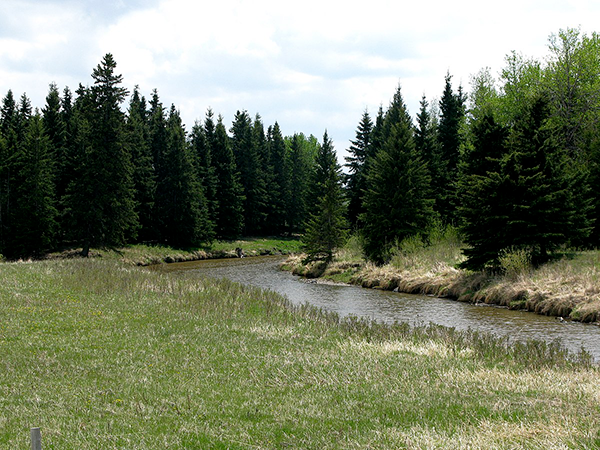Stewardship Showcase: When the Watershed is Your Home

This group is engaging the community to monitor watershed health.
Over the years, the Medicine River, situated southwest of Red Deer in central Alberta, had earned a reputation as dirty. But thanks to a comprehensive water sampling project over the last two years, the Medicine River Watershed Society (MRWS) has found the river to be in good shape.
After receiving a Watershed Stewardship Grant from Land Stewardship Centre in 2023, MRWS scaled up their water monitoring project that began the previous year. Until MRWS picked up testing again in 2022, the water hadn’t been tested since 2007 – and the results at that time were not positive.
But the 2022 and 2023 results show conditions have improved and, despite the brown hue of the river, the river’s health is improving.
Partnering with CreekWatch and the Red Deer River Watershed Alliance, the MRWS was able to conduct robust testing on water temperature, turbidity, dissolved oxygen, ammonia, phosphorus, pH and chloride. CreekWatch, a program led by the RiverWatch Institute of Alberta, provides the tools for citizen scientists to complete their sampling work. Mobilizing a team of volunteer citizen scientists, MRWS collected samples 15 times over 2023.
“The watershed is our home and volunteers are the local drivers,” explains Gary Lewis of the MRWS.
Gary is one of many players in this project, which has brought together different community groups and local residents invested in the watershed’s health.
“The project really speaks to the importance of synergy between volunteers and stakeholders. This is a shout out to the Red Deer River Watershed Alliance (RDRWA) for one, and specifically Darian Coulter. Darian might be an employee of the RDRWA but at the core he's an enthusiast. We could not accomplish what we have without the RDRWA partnership and his help,” Gary says. “Watershed work is a family affair.”
That synergy is valuable for both organizations – the health of the Medicine River, as a tributary of the Red Deer River, is inextricably linked to the health of the Red Deer River.
Local engagement is key, says Gary, because residents of the area have a vested interest in the river’s health. They recognize the watershed as a life-giving force.
“We care for the watershed like it's our own backyard. I want my grandkids to see a red wing blackbird, dragonflies, fish, moose, ducks. I want them to be able to skip stones, hear geese honk, watch water ripple and maybe catch a fish,” he adds.
MRWS held an event in November to share results with the community, which was well received. Community members turned out to hear about the progress made and celebrate the work that’s been done. Keeping those community members engaged is key to the river’s continued health and success, adds Gary. As are the cumulative impact of stewardship efforts taking place within the watershed including improved cropping, pasture and nutrient management practices, focused riparian management and alternative livestock watering practices, and community-based weed control efforts.
For Darian Coulter, monitoring work supports all kinds of important aspects of watershed health – including ongoing stewardship of the river.
“I hope that the sampling and results lead to a better understanding of the Medicine River watershed's health, which will help make decisions regarding conservation, management and restoration efforts,” Darian says.
They plan to continue monitoring the health of the river and inspire residents to stay engaged.
“To each of us, water is a matter of life, it's about health, welfare and beauty. We can't take it for granted. We need to do our part to make a positive difference. We need to be a voice for watersheds because "their" voice is observable but not audible,” adds Gary.


Leave a comment